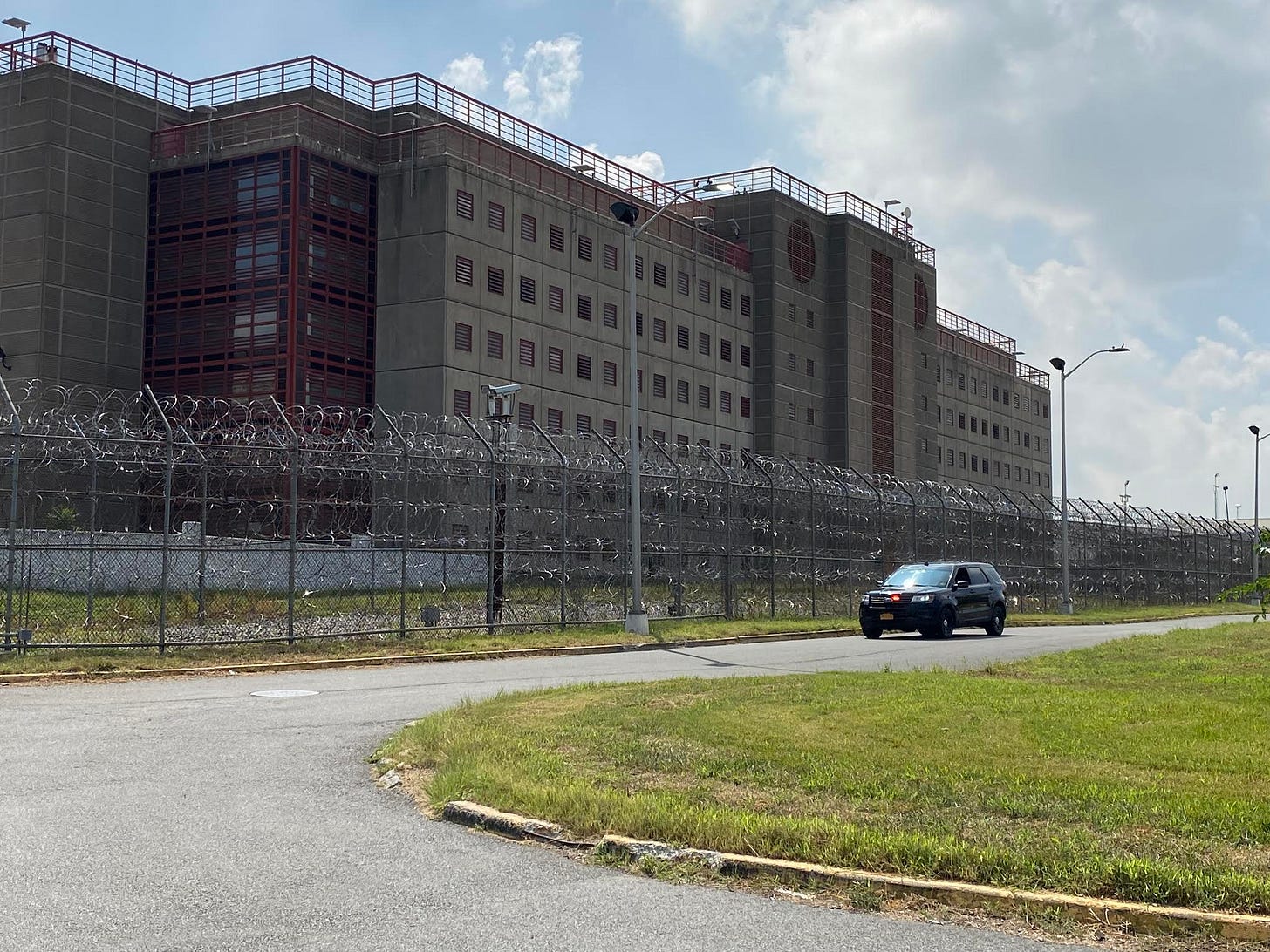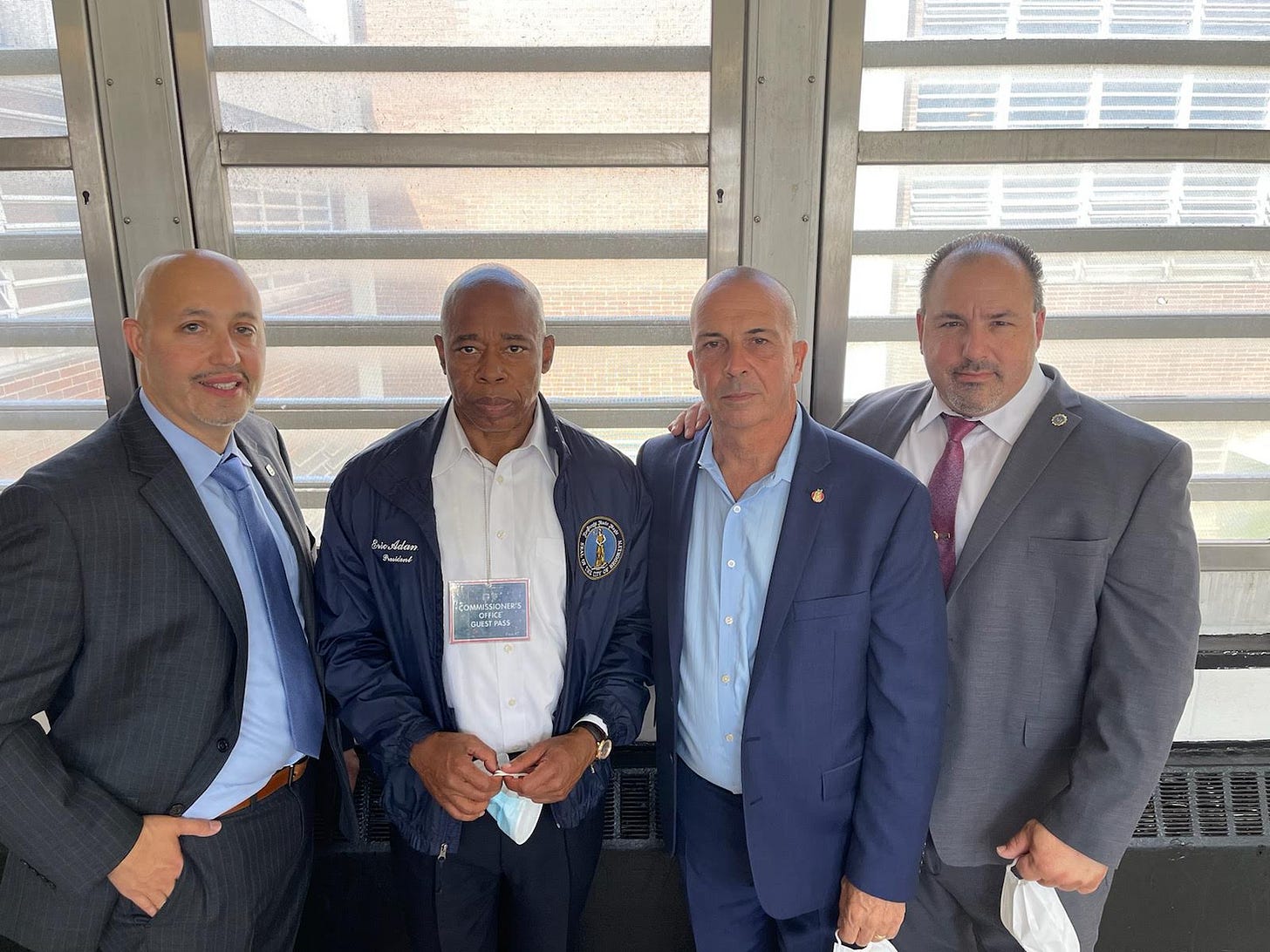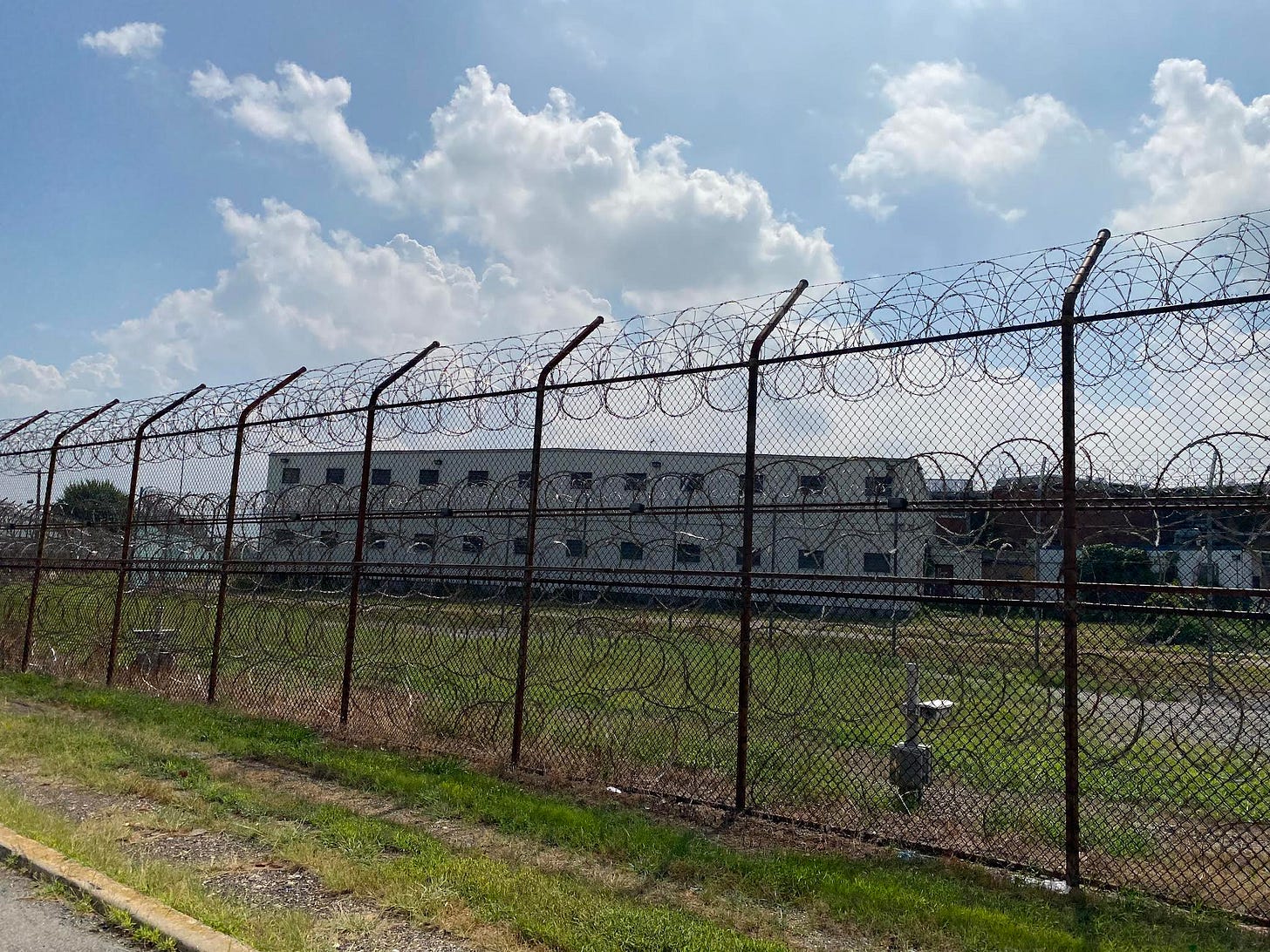Patrick Ferraiuolo is an NYC Department of Corrections Captain and President of the Corrections Captain Association. Pat originally joined as a Corrections Officer in 1982 and has worked on Rikers Island and the borough facility for 25+ years. Given all of the recent press stories about Rikers Island and building the mega-jail in Chinatown, I reached out to Pat to find out the truth about what’s been happening on Rikers Island.
Rikers Island, 2022
Jason: I once read that Rikers Island had a golden era in 1999 of reduced violence, increased morale, and peak performance. Tell me about this era.
Pat: It’s true, and the changing of the guard was what brought Rikers into this golden era. Before peak performance was achieved under Giuliani, Rikers was pretty crowded during the Dinkins administration. We had about 22,000 inmates at one time, but even with that high of a capacity it still wasn’t as bad as it is today. When Giuliani began his term, he was very open about his support for law enforcement and brought in Commissioner Kerik. Kerik came into the job without budget limitations. He cleaned up the jails, he paid maintenance, and he always fixed whatever needed to be fixed. Overtime was approved, and cleaning up the environment was a huge part of Rikers going in the right direction. He often visited the jails, came to the roll calls, and used to say “I support the corrections staff 100%, I will back you if you need to defend yourself, as long as you’re within the scope of the law.” The positive affirmations really boosted morale.
Punitive segregation was allowed, which gave us the ability to keep the violent inmates away from the inmates who just wanted to do their time and mind their business. We had great programs under Kerik like Scared Straight, and a military program called High Impact, there were also lots of helpful incentive programs. Good behavior for inmates was rewarded. If there was no violence in a housing area, inmates would get to watch movies, they would get extra time during their visits. Inmates were incentivized to do the right thing under Kerik, and after that, all of these programs continued under commissioner Frasier.
If a Corrections Officer were forced to defend themself, Commissioner Kerik would look at each individual case and if a C.O. was being treated unfairly, he made it known. You felt like it wasn’t a thankless job, you could do your job and you could defend yourself if you had to.
Under Kerik, the majority of the inmate population was content, people were doing the right thing, and they were not out of control. People enjoyed going to work on Rikers Island. I worked in one of the bigger jails back then as a security captain in punitive segregation, and there wasn’t a day where I questioned my career choice. Every day was a good day, there were no issues.
Jason: So when did all of these programs and procedures that brought Rikers to peak performance go away? And who made those decisions?
Pat: Things began to slowly fall apart during the twelve years of Bloomberg. His commissioners were not as hands-on as Kerik, they weren’t as supportive of corrections officers as the previous administration. The conversations about closing Rikers actually began at the end of Bloomberg’s term. This is when all the advisory groups came out against Rikers. Bloomberg was a money guy, he cut all of the programs I mentioned before that were great for inmates. Even Scared Straight ended under Bloomberg. Then everything really accelerated under Deblasio. In my humble opinion, Deblasio destroyed Rikers Island on purpose so he could close it.
COBA President Benny Bosico, Mayor Adams, Patrick Ferraiuolo, and ADW Deputy Warden’s Association President Joe Russo
All of the progressive orgs attacked us in unison under Deblasio. Legal Aid, The Board Of Corrections, and then eventually Judge Litman decided that Rikers must be closed within a certain amount of years. After that, attrition became a real issue for us.
The facilities were deliberately neglected under DeBlasio’s administration so these groups could then say “Look how horrible this place is, we were right and we have to close it.” Over the last four years, they hired some corrections officers, but nowhere near the amount they need. They’ve hired no captains, I haven’t had a captain’s class in almost four years. So my membership has diminished by about 300 over this time frame. Besides the dilapidation of the facilities, the lack of support for the corrections staff was so bad that it brought morale to an all-time low.
Jason: How many C.O.s does it take to staff Rikers properly?
Pat: A better way to phrase it is that the ratio on paper should be about 10 to 1, or 10 Corrections Officers to 1 inmate. We really believe that, and the new commissioner also agrees and has submitted this number to the budget. Rikers Island is a city within a city. There are so many posts, so much transportation, support services, and industries in place that are necessary for the island to function.
Jason: There’s a number that gets thrown around that it costs $438,000 per prisoner per year to keep someone on Rikers Island. Can you explain this to me?
Pat: This number doesn’t make any sense because nothing has changed at all on Rikers Island in the last 20 years that would reflect that. Let’s go back to the attrition, not hiring Corrections Officers and Captains for the last four years. My captains have the option to work overtime every single day which gives them the ability to double their salary. They would save a lot of money by hiring new officers and new captains instead of paying the crazy overtime.
Jason: What is the maximum capacity of Rikers Island?
Pat: Right now we run 6,000 inmates but three major facilities there are currently closed. We could fit a lot more than 6,000 currently, but the condition of these facilities prevents us from doing so. Running a program with 10,000 inmates on Rikers is completely doable. I don’t understand why we’re talking about closing down Rikers when we could just build State-of-the-art facilities there while keeping it open, including a separate mental institution. There’s plenty of space, it’s all completely doable.
Jason: How much of Rikers population are people with severe mental illness?
Pat: The simple answer would be how many people are under mental observation at Rikers Island, but unfortunately you can’t trust that number because inmates game the system. They pretend to have a mental illness, manipulate the psychiatrists and end up doing their time in a mental observation unit. It’s been going on forever. Obviously, NY State closed down our inpatient mental health facilities over the years, and many of those people ended up on Rikers Island. My guess is around 25% of the Rikers population has severe mental illness issues but mixed in with many who are just pretending. They’ll come in, they’ll get evaluated by a psychiatrist when they’re new admissions. Sometimes they are labeled at this moment, or later they’ll be acting out in a facility and a corrections officer will send them to the clinic saying “needs to be evaluated” and they’ll get moved to one of the separate mental observation units.
Under the Kerik administration, every single corrections officer and captain that worked in the mental observation facilities had special training. They wore different uniforms and pins that signified their training. They had a steadying effect on those areas. That all went away during the Deblasio administration. He had untrained officers working with severely mentally ill inmates and it doesn’t work. We had it right, but it was all taken away via budgeting issues.
Jason: Tell me about the recent trend of reducing the population at Rikers
Pat: Bail reform has played an enormous part in capacity reduction. Inmates that we would have had in our custody in the past are no longer in our custody because of bail reform. If you look at the list of reasons to let people go and not have a bail set, it’s kinda ridiculous. Another thing was when Covid hit, Corrections Officers were dying too. I lost several active Captains from different offices. The beginning of Covid was a scary time for everyone, It reminded me of the AIDS epidemic in the 80s. A tremendous amount of Corrections Officers were calling out sick, and frankly, some were just afraid to come back to work. So what did they do? Instead of trying to fix this issue, they just started releasing inmates that should have never been released. Rikers Island is really just a numbers game to politicians, they will do anything to reduce the population. One of the things they kept saying was how we need to make it easier for people to visit inmates, but during Covid they moved all of the women inmates 50 miles upstate to another facility, proving their concern about making visits easier was just another lie.
The movement to get everyone out of Rikers has made the streets of NYC significantly more dangerous, and it’s being done by design. The politicians think we need fewer people on Rikers Island and pretend to not see the chaos this has caused, but the truth is we need to detain society’s most dangerous criminals on Rikers Island to make New York City safer. It’s that simple.
Jason: How often does a Corrections Officer get hurt on the job?
Pat: Since the Adams administration began, Corrections Officers are getting hurt on the job way less than they were before. I have nothing but good things to say about Eric Adams and Commissioner Molina when it comes to Corrections. In previous administrations, assaults on staff easily ran 50 a day or higher. I did an audit recently on incidents and didn't even have one page to review. There were a couple of uses of force, but nothing horrible, no fires. Incidents are down dramatically, but to answer your question: Every single day, Corrections Officers are assaulted by inmates. There is not one day that passes where there is not an assault on a staff member.
Rikers Island, 2022
Jason: Tell me about inmates lighting fires, is this a common thing?
Pat: Fires got really bad the last couple of years. We were averaging between 6-12 fires a day, every single day. Now they are far and few between. They still occur, but nowhere near how bad it was during the Deblasio administration.
Jason: How dangerous would you consider the current population on Rikers Island?
Pat: 10 out of 10. It’s bad. Bail reform is actually a great indicator of how violent the current population of Rikers is. Because bail reform means we now incarcerate fewer people, in order to have bail set, you have to be one of the most dangerous people in NYC.
We had 20,000 inmates at one point, but back in those days a lot of them just wanted to be left alone and do their time. Currently, we have 6,000 inmates, and the majority of them are gang affiliated. Judges set bail on them because they were a clear danger to society. I worked 25 years in the jails, and this current group might be a lot smaller than previous years, but smaller doesn’t mean less dangerous. Think about the chaos you see out in the streets of NYC right now, only the absolute worst of that group are currently in here.
The current population at Rikers has no respect for human life, not yours, not even their own.
This concludes part 1 of 4.
To be continued…






